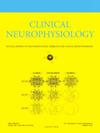50赫兹-重复经颅磁刺激调节帕金森病的大脑连通性
IF 3.7
3区 医学
Q1 CLINICAL NEUROLOGY
引用次数: 0
摘要
目的高频重复经颅磁刺激(rTMS)可以调节神经元的兴奋性,促进“亲动力”的伽马频率,同时减弱“反动力”的β频率。本研究探讨了50 Hz-rTMS和间歇性Theta Burst Stimulation (iTBS)对初级运动(M1)和背外侧前额叶皮层(DLPFC)的刺激是否能增强帕金森病(PD)运动回路中的伽马活动和功能连通性。方法对62例PD患者经50hz - rtms和iTBS治疗后的介入脑电图进行研究。功率谱分析,以及嵌入在图论度量中的相干性和互信息,被用于评估整个大脑的功能连通性。结果发现iTBS后左M1的聚类系数和局部伽马活动效率发生了变化,50 Hz-rTMS后感觉运动回路发生了广泛的变化。我们没有发现功率谱的变化,也没有发现运动皮层内外的伽马活动的夹带。结论目前的50hz - rtms方案可调节PD患者的功能连通性,但不能调节功率谱。这些拓扑变化不转化为临床效果。这些刺激方案可能缺乏特异性,无法在临床上有效。高频rTMS为研究伽马带宽下的大脑连接提供了新的见解。本文章由计算机程序翻译,如有差异,请以英文原文为准。
50 Hz-Repetitive transcranial magnetic stimulation modulates brain connectivity in Parkinson’s disease
Objectives
High-frequency repetitive transcranial magnetic stimulation (rTMS) may modulate neuronal excitability and promote the presumed “pro-kinetic” gamma frequency, while attenuating the “anti-kinetic” beta frequency. This study explores whether 50 Hz-rTMS and intermittent Theta Burst Stimulation (iTBS), of the primary motor (M1) and dorsolateral prefrontal cortex (DLPFC) enhance the gamma activity and functional connectivity within the motor circuit in Parkinson’s disease (PD).
Methods
We investigated pre- and post-rTMS interventional EEG in 62 PD patients following 50 Hz-rTMS and iTBS. Power spectral analysis, along with coherence and mutual information embedded in metrics of graph theory, was applied to assess the functional connectivity across the whole brain.
Results
We found changes in the cluster coefficient and local efficiency of gamma activity in the left M1 following iTBS, and wider-spread changes within the sensorimotor circuit following 50 Hz-rTMS. We found no changes in the power spectrum or entrainment of the gamma activity in the motor cortex or beyond.
Conclusion
The current 50 Hz-rTMS protocols modulate functional connectivity in PD patients, but not the power spectrum. These topological changes do not translate into clinical effects. These stimulation protocols may lack the specificity to be clinically effective.
Significance
High frequency rTMS provides new insights in brain connectivity in the gamma bandwidth.
求助全文
通过发布文献求助,成功后即可免费获取论文全文。
去求助
来源期刊

Clinical Neurophysiology
医学-临床神经学
CiteScore
8.70
自引率
6.40%
发文量
932
审稿时长
59 days
期刊介绍:
As of January 1999, The journal Electroencephalography and Clinical Neurophysiology, and its two sections Electromyography and Motor Control and Evoked Potentials have amalgamated to become this journal - Clinical Neurophysiology.
Clinical Neurophysiology is the official journal of the International Federation of Clinical Neurophysiology, the Brazilian Society of Clinical Neurophysiology, the Czech Society of Clinical Neurophysiology, the Italian Clinical Neurophysiology Society and the International Society of Intraoperative Neurophysiology.The journal is dedicated to fostering research and disseminating information on all aspects of both normal and abnormal functioning of the nervous system. The key aim of the publication is to disseminate scholarly reports on the pathophysiology underlying diseases of the central and peripheral nervous system of human patients. Clinical trials that use neurophysiological measures to document change are encouraged, as are manuscripts reporting data on integrated neuroimaging of central nervous function including, but not limited to, functional MRI, MEG, EEG, PET and other neuroimaging modalities.
 求助内容:
求助内容: 应助结果提醒方式:
应助结果提醒方式:


